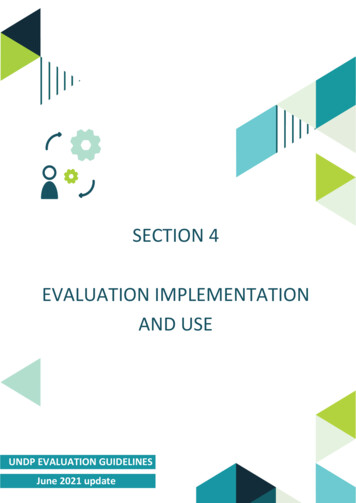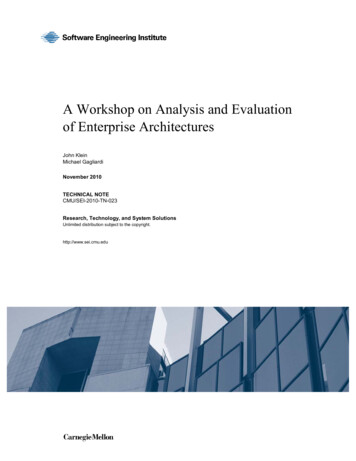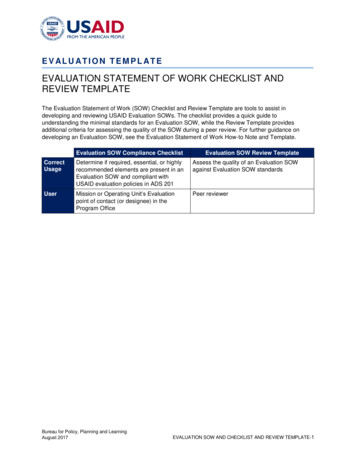
Transcription
A Service User Evaluationof the IAPT for SMIDemonstration SitesPrepared for NHS England by:Agnes Hann, Laura Hemming, Julie Billsborough,Lisa Couperthwaite, Elaine Hewis,Vanessa Pinfold and Sarah Hamiltonresearchers at the McPin FoundationAugust 2015
:IAPTServiceNon- erviewSchedules.672
gsfromauser- ach,consistingof: onsites(241IAPTserviceusers,and64IAPTservicenon- ‐users)Semi- positivelyontheirday- ‐to- service:1. Simplificationofthereferralprocess.2. dforcompletion.3. tavailablelocally.4. yDisordersinparticular.5. mationaboutwaitingtimesattheoutset.6. ingthewaitingperiod.7. ingthedeliveryofthetherapy.8. e’throughout.9. rovidingavalidatingatmosphereandnon- ‐judgementalapproach.Self- ‐disclosuremaysometimeshelpwiththis.10. sessions.11. work/childcarecommitmentsandtravelproblems.12. Increasedfollow- ‐upsupport.3
BackgroundImproving Access to Psychological Therapies (IAPT) started in 2006 to support the provision of talking therapies forpeople of working age with depression and anxiety. In 2011, the Government made a commitment to expand accessto psychological therapies in England to include three new strands: children and young people; people with long-termphysical conditions or medically unexplained symptoms, and people with a severe mental illness (SMI), specifically,with diagnoses of Psychotic Disorders, Bipolar Disorder and Personality Disorders (Department of Health, 2011).In November 2012, six demonstration sites were selected and funded to deliver IAPT for people with SMI, and thesepilots were operational until 31 March 2015. The sites were chosen for their ability to deliver NICE approved andevidence based psychological therapies to people with diagnoses of Psychotic Disorders, Bipolar Disorder andPersonality Disorders as a frontline therapy. The sites are1:Providing psychological therapies for Psychosis: Lancashire Care NHS Foundation Trust2South London and Maudsley NHS Foundation TrustProviding psychological therapies for Bipolar Disorder: Birmingham and Solihull Mental Health Foundation Trust and Spectrum Centre for Mental HealthResearch, Lancaster University (working in partnership)Providing psychological therapies for Personality Disorders: Barnet, Enfield and Haringey Mental Health TrustNorth East London NHS Foundation TrustSomerset Partnership NHS Foundation TrustThese pilot sites are being evaluated to determine the benefits of IAPT for SMI to service-users, the staff working inservices, the NHS and the economy as a whole.This report forms part of the overarching IAPT for SMI evaluation by presenting the views and experiences of peoplewho used the services in these six demonstration sites following a user focused evaluation design. It sought to captureviews from people who completed and benefited from the therapy, and also those who did not engage, discontinuedtheir therapy or did not benefit. The evaluation was commissioned and funded by NHS England, as the bodyresponsible for making recommendations around the commissioning of these services. The specific aims of this serviceuser evaluation are:1.2.3.4.5.12To capture the perspectives of those using the service in relation to the effectiveness of IAPT for SMITo describe the experiences and levels of satisfaction of those using the IAPT for SMI servicesTo capture the views and rationale of those who chose not to use the IAPT for SMI servicesTo capture any recommendations for improvements in the IAPT for SMI servicesTo compare the views of those who completed therapy and those who did not complete therapySee Appendix 1 for more information about each of the sites and the services they provide.For brevity, throughout this report we refer to the sites as follows: Lancashire; SLaM; BSMHFT; BEH; NEL and Somerset.4
MethodologyCollaborative ApproachThis project proactively sought to put the views of people living with a severe mental illness at its heart throughworking collaboratively with researchers who had this personal experience themselves. The evaluation team consistedof three ‘peer’ or ‘service user’ researchers working alongside two researchers based at the McPin Foundation. Thepeer researchers were integral to all phases of the project – evaluation design, data collection, analysis and reporting– and conducted all of the qualitative interviews. There was also scope for them to provide some localised logisticalsupport to the sites. In addition to the involvement of the peer researchers, the project consulted with a number ofservice user representatives from the sites, as well as the McPin Foundation’s own Peer Review Panel, which consistsof service users and carers, on the design of the data collection tools.This collaborative approach was felt to be important to providing a good understanding of the experiences of peopleusing the service, to build rapport with those people being interviewed, and to ensure that the views of potentialbeneficiaries were kept as the central focus of the evaluation at all times. Towards the end of this report, our peerresearchers offer some reflections on their experience of having been involved in this evaluation.Evaluation DesignThe study was designed in two stages: First, a survey co-designed with the peer researchers, the demonstration sites, and the McPin team to capturefeedback from people using IAPT for SMI services, or those invited to use servicesSecond, a strategically selected sample of survey respondents from across the sites were interviewed by peerresearchers to explore views and experiences in greater detailSurveyThe key objective of the survey questionnaires was to capture as wide a range of views as possible. We developed twoseparate questionnaires (Survey 1 and Survey 2 – see Appendix 3) for distribution across service users who did, andthose who did not, use the IAPT for SMI service. In doing so, we drew on the specific evaluation questions raised bythe tender, the lived experience of the team members, and previously developed questionnaires on related topics.This included our own ‘Talking Back’ survey which was previously developed with service users for use in IAPT servicesin London, as well as the brief Patient Experience Questionnaire (PEQ) used by the IAPT for SMI sites. Both versions ofthe IAPT for SMI questionnaires were reviewed by our Peer Review Panel. Each of the questionnaires was modified tofit with the specificities of each service and make it as relevant as possible to potential respondents. In some cases,this involved adding extra questions or answer options, or removing questions that were not felt to be relevant. Wealso adapted the wording of questions to correspond to the wording used by the services. For example, some of thePersonality Disorder services requested that we used the word ‘treatment’ instead of ‘therapy’.3Survey 1 (IAPT service users) 3Those in the process of having therapyThose who had completed therapyFor simplicity, throughout this report, we use the word ‘therapy’.5
Those who had started, but discontinued therapySurvey 2 (IAPT service non-users) Those that were referred to the service but did not complete an assessmentThose that completed an assessment with the service but did not go on to receive therapyIn-depth interviewsFor the second phase of the evaluation, two interview schedules were developed by the team to address the questionsoutlined in the tender document in more depth and explore the range of experiences of the services (see Appendix 4).Both interview schedules were reviewed by service user representatives from the demonstration sites.Data CollectionSurveyWe worked closely with each of the six sites to ensure that the questionnaire was made available to all service userswho had engaged with the service since it became a demonstration site in November 2012. It quickly transpired thatgiven the time and budgetary constraints on the project, post, rather than email or distribution at the sites, would bethe most appropriate mechanism for distribution, and ensured that only eligible respondents received a questionnaire.Some sites were provided with posters to help publicise the survey, and localised support, for example, help with fillingout the survey at a service user event, was provided by the peer researchers where requested.Questionnaires were addressed and posted out by the services themselves, with one service requesting that the McPinFoundation use their own franking facilities to send the envelopes once these had been addressed by the service. Theapproach taken was to provide flexibility to the sites to encourage maximum engagement in the process. Completedquestionnaires were returned directly to the McPin Foundation offices using a supplied freepost envelope.Respondents could choose to remain anonymous; however, we invited all respondents to indicate whether they wouldbe willing to take part in an interview, and to provide contact details if so. To encourage responses, we offeredrespondents entries into a prize draw to win prizes worth up to 100, with contact details for the prize draw filled inon a separate slip which was removed from the survey upon receipt. A small number of questionnaires werecompleted at service user events attended by peer researchers, who were able to offer respondents support withcompletion where this was needed.In-depth InterviewsWe selected a sample of participants to interview from those who indicated that they would be interested in this intheir returned questionnaire. We sought to interview 10 service users from each site – a total sample size of 60 – andlooked to sample strategically, rather than representatively, capturing a range of length of engagement (includingpeople who chose not to engage), experiences and demographics. Our final sample was limited by the number andtype of opt-ins to interview for each site, and was as follows:6
Table 1 – Interviewees’ engagement with the IAPT for SMI serviceBEHBSMHFTLancashire NELSLaMSomerset TotalPeople who chose not to engagewith the IAPT SMI service2102139People who started with the IAPTSMI service but did not complete20031713People who completed sessionsand report broadly positiveexperiences15425219People who completed sessionsand report broadly middling (or atleast some negative) experiences.54233320Total1010610101561During the interview set-up, all participants were given clear information about the evaluation, including aroundconsent, anonymity and confidentiality, and completed a Participant Preference Form with a member of theevaluation team. Participation in the interviews was incentivised with a 20 shopping voucher. The vast majority ofthe interviews were conducted over the phone at a time that was convenient for them, ensuring that there wasevening and weekend availability of interviewers. One participant had a strong preference for a face-to-face interview,which we were able to arrange. All participants consented to their interviews being audio recorded and transcribed.All interviews were carried out by the peer researchers, who had a ‘Distress Flowchart’ they could refer to if they hadany concerns about a participant’s wellbeing. They were also encouraged to remain aware of their own wellbeingthroughout the duration of the project, and to seek support from the researchers at the McPin Foundation if needed.Analysis and ReportingQuantitative analysis was completed using Microsoft Excel software. Statistics were conducted descriptively, includingwhere comparisons were made, as the small samples sizes generally meant that inferential analyses wereunwarranted. The majority of the quantitative analysis was split across Survey 1 (people who used the IAPT service)and Survey 2 (people who were referred to, but did not use, the IAPT service) responses, as many of the questionswere not transferrable across the two subpopulations of respondents. However, a small number of questions wereincluded in both surveys, and for this reason demographic data and data on referral routes are presented across bothgroups of respondents. All analyses presented on ’IAPT service users’ refer to those people who were eligible forSurvey 1: those in the process of having therapy; those that had completed therapy; those that had discontinuedtherapy; and those that were about to begin therapy. All analyses that are presented on ’IAPT service non-users’ referto those people who were eligible for Survey 2: those that were referred but did not complete an assessment; andthose that completed an assessment and did not go on to receive therapy. It is important to remember that the totalnumbers – even when aggregated across all sites – represent small numbers of individuals who chose to opt in to thisevaluation, and should not be assumed to represent the experiences of IAPT for SMI service users and non-users as awhole.7
Qualitative analysis was completed thematically. Part way through data collection, the team met and agreed on aninitial set of themes based on the analysis of a small number of transcripts. Towards the end of the interviewing phase,a coding framework was finalised over the course of a two-day analysis session, with all transcripts analysed by at leastone member of the evaluation team. This analysis process was also applied to all of the qualitative comments providedin the surveys. Throughout the report, the qualitative data is intended to illustrate in more detail the diversity ofexperiences reported, rather that proportionally represent the frequency of certain kinds of experiences, and quoteswere selected for inclusion in this report on the basis that they communicate a range of experiences succinctly andengagingly. It is also important to note that the project timescales did not permit us to analyse the qualitative data inmore depth, but there will be scope to do this in an addendum to this work due to take place from April – August 2015,on the basis of which the evaluation team hopes to produce a peer review publication.8
Respondent CharacteristicsThe overall response rate for Surveys 1 and 2 combined was 12%, ranging from 5% to 21% across the different sites.4The total number of surveys completed was 305, with 241 IAPT service users completing surveys, and 64 IAPT servicenon-users. Of those who completed the survey (n 305), 60% (183 individuals), opted in to the interview phase. Table2 below provides an overview of the response rates for both surveys broken down by site.Table 2 – Response rates by siteTotalsample(n 305)Number sentNumberreceivedResponserateBEH(n 57)BSMHFT(n 31)Lancashire(n 16)NEL(n 57)SLaM (n 79)Somerset (n 65)EI(EIT %10%10%6%17%11%13%21%12%17%Table 3 on the following page provides an overview of the demographic characteristics of people taking part in thesurvey, broken down by site:54A number of sites reported that they were aware that some surveys may have been returned undelivered due to having an outdated addresson record. As one of the site’s surveys were posted from our office address, we were able to ascertain the delivery failure rate for this site,which was 1.8%. This was one of the London sites, in an area where people are arguably more likely to move addresses frequently, and wetherefore estimate that the overall delivery failure rate would be no higher than this for the sample as a whole.5In the creation of all the tables and graphs in this report, we have excluded data that was missing, ‘prefer not to answer’, or ‘not applicable’unless otherwise specified.9
le(n e&BlackAfrican/Caribbean,White&Asian)Other4016- ‐764016- ‐76Survey243(70%)BEH(n - ‐64TotalBSMHFT(n 31)3920- ‐613920- ‐595449- ‐61TotalSurvey22(100%)0(0%)4019- ‐684019- ‐68Lancashire(n 7%)1(100%)56562316- ‐292316- ‐29NEL(n (12%)SLaM(n (39%)22(38%)Somerset(n (23%)12(23%)3(25%)24244018–674018- ‐673520- ‐504019- ‐694019- ‐694128- ‐534120–764220- ‐764123- 0(0%)1(8%)2(3%)1(2%)1(8%)0(0%)0(0%)0(0%)
dnon- ian.Overhalfofthesurveyrespondentsself- testheself- n 305)N%BEH(n 57)BSMHFT(n 31)Lancashire(n 16)NEL(n 57)SLaM(n 79)Somerset(n agnosis’isself- ‐reported.
interview was limited not only by who opted in to this stage of the evaluation, but also by whether or not they werecontactable within a certain timeframe.Table 5 – Interview participants’ hite (British,Irish, gypsy)Black (African,Caribbean)Asian (Indian,Pakistani,Bangladeshi,Chinese)Mixed (White& BlackAfrican /Caribbean,White &Asian)PNA / MissingTotalsample(n 61)N%3867%1933%BEH (n 10)4120-764333-59N82%80%20%BSMHFT(n 10)N72%78%22%Lancashire(n 6)N424732-57%67%33%NEL (n 10)N722624-29%78%22%SLaM (n 10)N553720-66%50%50%Somerset(n 0%00%220%110%213%The diagnoses given for each service broadly reflect the diagnosis specific target groups (BEH, NEL & Somerset offeredPersonality Disorder services; BSMHFT offered a Bipolar Disorder service, and Lancashire and SLaM offered Psychosisservices). Somerset had two services included in the survey, one for primary care users and one for secondary careusers, which has resulted in a more diverse range of diagnoses being included. Almost half of our overall sampledescribed themselves as having a diagnosis of Personality Disorder. Around a quarter of respondents indicated thatthey had a diagnosis of Psychotic Disorders, Bipolar Disorder or other diagnoses. Only 8% of the sample was unsure oftheir diagnosis.Figure 1 below shows how far through therapy IAPT service user respondents were at the time of completing thesurvey. Over half had completed their therapy. A further quarter were part way through therapy at the time of surveycompletion, whilst just over 10% had started and stopped part way through. Around 60% of respondents had beguntheir therapy within the past year.12
Figure 1 – Stages of treatment of IAPT service usersHow far through treatment are you?(n 236)None of these, 6%About to start, 5%Completed, 52%Part way through,25%Started andstopped part waythrough, 11%Figure 2 indicates how far along IAPT service non-user respondents were before deciding not to engage further withthe service. Over half of these respondents had been assessed, but not continued to therapy, while around a fifth werereferred to the service but did not complete an assessment. Just under half of IAPT service non-users had receivedtheir referral letter within the past year.Figure 2 – Stages of treatment of IAPT service non-usersHow far through treatment were you?(n 61)None of these,18%Referred notassessed, 21%Not sure / can'tremember, 8%Assessed nottreated, 53%13
Findings: IAPT Service UsersAccessing the ServicesReferral processFigure 3 indicates how IAPT service users were referred to the service. Just under a third were referred by their GP,while over half were referred by either a psychiatrist or another mental health professional. The qualitative datahighlighted many accounts of positive experiences with GPs in relation to the referral process.Figure 3 – Referral routes for IAPT service usersReferral routes (n 224)Social worker,4%Other, 4% Not sure , 3%Referred myself,6%GP, 30%Other MHP, 24%Psychiatrist, 29%Waiting timesFigure 4 overleaf shows IAPT service users’ satisfaction with waiting times, broken down by site. Fifty-five per cent ofservice users were either satisfied or very satisfied with the waiting times. Only 29% were either very dissatisfied ordissatisfied with the waiting times. IAPT service users were also asked about their satisfaction with the support offeredduring the waiting time. Fifty-six per cent of service users were either satisfied or very satisfied with the support thatwas provided during the waiting times. This varied between the sites with a range of 40% to 74%. Overall, 23% werevery dissatisfied or dissatisfied with the support offered during waiting times.14
Figure 4 – IAPT service users’ satisfaction with waiting timesSatisfaction with waiting times (n 240)100%90%80%70%BEH (n 37)60%Birmingham (n 28)50%Lancashire (n 15)40%NEL (n 42)30%SLaM (n 65)20%Somerset (n 53)10%Average line0%Very satisfied / satisfiedNeitherVery dissatisfied / dissatisfiedThe qualitative data revealed that some IAPT service users felt that the waiting times were reasonable, or even fasterthan expected, and good communication around the waiting time, for example being no
First, a survey co-designed with the peer researchers, the demonstration sites, and the McPin team to capture feedback from people using IAPT for SMI services, or those invited to use services Second, a strategically selected sample of survey respondents from across the sites were interviewed by peer











